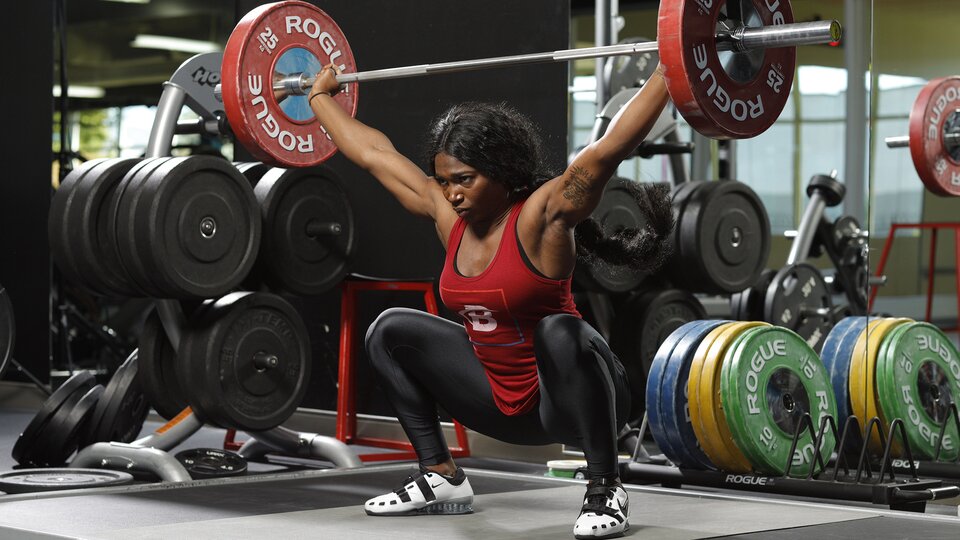Products You May Like
What is Olympic Lifting | Learn the Olympic Lifts | Olympic Lift Variations | Olympic Lifting and Bodybuilding | How to Master the Olympic Lifts | How to Prep for a Weightlifting Meet
The beauty of Olympic weightlifting is its simplicity. There are only two lifts, so if you’re getting better at them, you’re getting better period. But the downside of weightlifting, as anyone who has gotten deep into the sport can tell you, is that those two lifts are endlessly challenging, and building your expertise at them is a project of years—not weeks or months.
Have you fallen in love with the snatch and clean and jerk and are ready to see how far you can take them? Here’s the technique, scheduling, and mindset that separates casual lifter from master, from three elite lifters who have competed on the national and world stage.
Here Are Your Teachers
- 2021 USA Olympic Team
- 2xYouth World Champion
- 4xJunior World Champion
- American and World Record Holder
- Masters World Record Holder
- 2021 Masters World Champion
- 2019 49kg National Champion
1. Master Your Overhead Position
The barbell snatch is a demanding lift for many reasons, but one of the biggest is the special combination of stability and mobility that it requires. And no, it’s not just shoulders. Your hips, ankles… everything’s getting tested. Need a standard to aim for? Here’s one: If you’re going to reach your snatch potential, you should probably be able to do a Sots press.
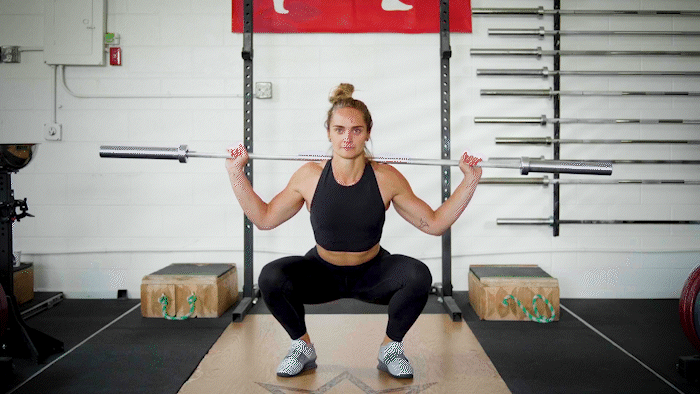
To do this drill, you need excellent mobility in your thoracic spine, your shoulders, hips, knees, and even your ankles. And they won’t happen by accident. As Kristi Brewer puts it, ”People don’t take the time to improve their mobility. If you want to be better at lifting, that’s going to have to be a priority.”
These two drills make great warm-ups or accessory work to get you closer:
- Seated Sots press: Sit on a very low box or bench with your heels firmly planted on the ground, ribs down, and core tight. Don’t allow your back to arch as you press the bar up.
- Kettlebell press in squat: Some people just can’t seem to get the barbell behind their head. If that’s you, use two light kettlebells and press from the front-rack position.
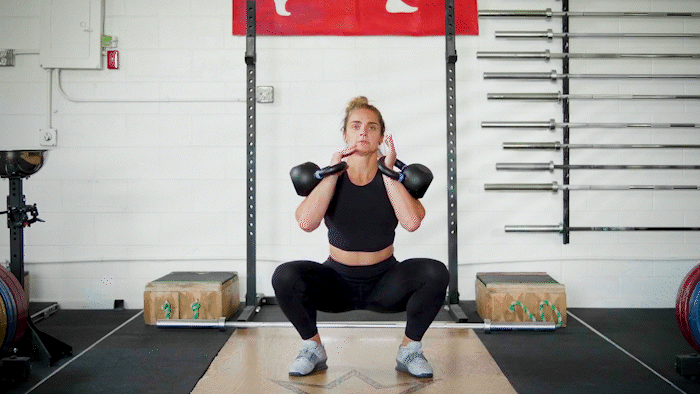
Pro tip: A pair of high-heeled lifting shoes make this lift more manageable, particularly if your hips or ankles are holding you back.
However, even the best shoes aren’t an excuse not to do the work. Three of Brewer’s favorite drills to focus on include:
2. Master Your First Pull
Getting the barbell from the ground to the front-rack or overhead position demands more than just yanking it as hard as possible off the floor. There needs to be a huge transfer of power from your body to the bar. Doing that demands powerhouse hamstrings and glutes, and stability in your core.
Performing snatch and clean deadlifts are great ways to improve your pulls and get a better mastery of technique, but remember: This isn’t powerlifting and the goal isn’t to lift as much as possible.
“Over the years,” says Sarah Wright, ”I focus less on weight on these lifts, and more on the real value of the technique for fixing small imbalances.”
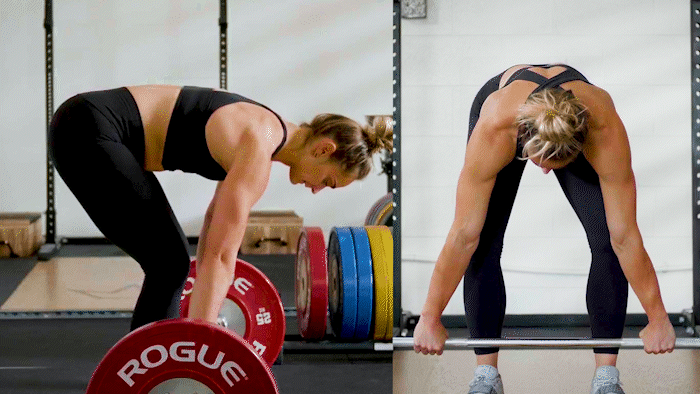
If you’re coming from a non-Olympic lifting background, the clean deadlift can feel like a mystery. Here are major differences to keep in mind as you do it.
- Use a hook grip, with your thumb on the bar and your first two fingers over it.
- Keep your biceps facing each other as much as possible, rather than facing forward.
- Your hips, knees, and shoulders should rise at the same time.
- Keep your back flat and your lats engaged by pulling the bar into you.
- Press through the ground and keep your chest over the bar for as long as you can.
- Stand up by squeezing your glutes hard.
3. Master Your Front Rack
The front-rack position is another mobility mystery that can keep OK lifters from becoming great ones. But solving it is essential! When you’ve got a load of heavy weight on your shoulders, you need to be confident and ”comfortable” enough to summon the force to put it over your head.
The best way to build that strength, mobility, and comfort? Maintain that position for time in an isometric hold. Sorry, not sorry.
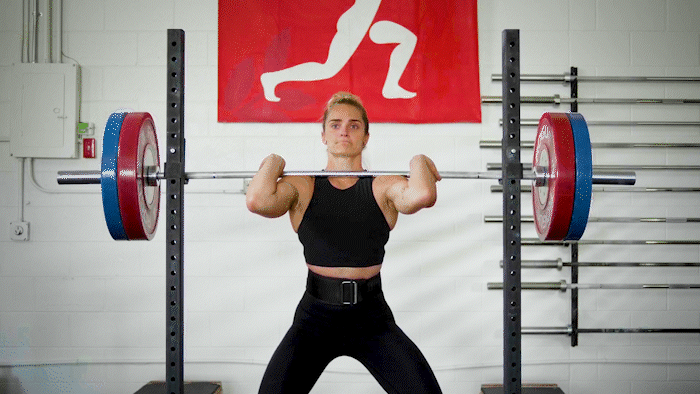
To get the full benefits, you’re going to have to build up to loading the bar with more than 100 percent of your clean weight, holding it for at least 15 seconds. Somewhere between 103-118 percent or more. Opening your thoracic spine against a wall and stretching your triceps around this drill can help as well.
4. Master Your Ego
Want to go heavy? You have to start light. Sorry, this is even true for people who can snatch 330 pounds and clean and jerk 420 at a body weight of under 165 like world record holder CJ Cummings. (Seriously though, ponder how heavy that is!)
The first-time Team USA Olympic team member says that chasing their max is the biggest mistake people can make when weightlifting. ”People think they need to be ’at a certain level’ or hit a certain weight. They’re more worried about what everyone else is lifting than what they’re lifting.”
One way to ensure you stick to weights you can control? Using a 1RM calculator and hanging out in the sweet spot of 70-80 percent is one way. Here’s another: Don’t end your rep after a clean and jerk. Overhead squat it! This is a common technique you’ll see on CJ’s training-focused Instagram feed.
Going heavy overhead is never easy, but it’s more comfortable with quality wrist wraps.
5. Master Your Schedule
Yes, the Olympic lifts can be part of a general strength or bodybuilding-focused approach to training. But if you want to master the lifts, doing them once a week on leg day won’t get you there. Here are how these elite lifters schedule their lifts:
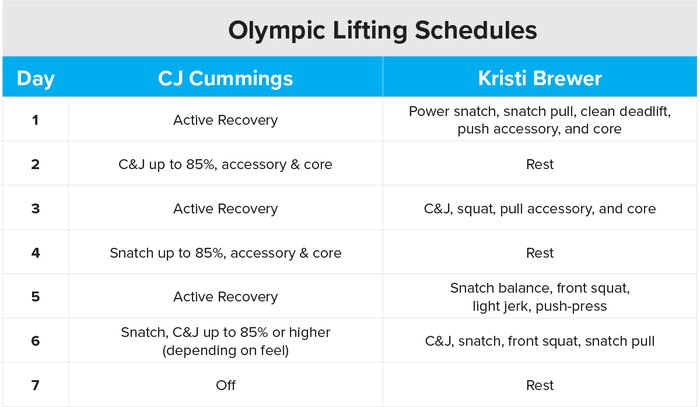
Wright takes this skill-focused approach to the next level. She trains seven days a week for between 1.5 and 3 hours, mixing light and heavy Olympic lifts with targeted assistance work like power cleans and high-bar back squats. But don’t let “assistance” make you think it’s light!
6. Master Your Nerves and Do a Competition
If you want to see where you stack up mentally and physically, there is no better way than to do a weightlifting competition. It’ll give you purpose and direction, and force you to confront your weaknesses head on. It also puts you in a community of people with the same passion as you.
“I love the energy that comes from competition,” says Brewer. ”And then all the people. I’ve met people from all over the world because of weightlifting—I think that’s really cool.”
If you’re really trying to master the lifts, competing is essential. On the platform, it’s just you against the barbell. Find a local or regional meet, embrace the challenge, and see what you’re made of.
